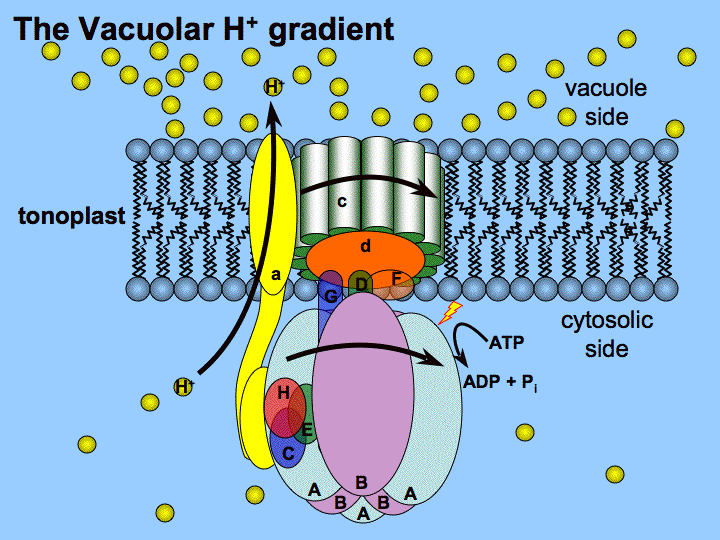

- #PROTON MOVEMENT ACROSS MEMBRANE DRIVES ROTATION OF C RING FOR FREE#
- #PROTON MOVEMENT ACROSS MEMBRANE DRIVES ROTATION OF C RING SERIES#
In this cycle, known as the Q cycle, electrons arrive from CoQ in pairs, but get passed to cytochrome c individually. It accepts electrons from coenzyme Q in electron transport and passes them off to cytochrome c. The complex contains 11 subunits, a 2-iron ferredoxin, cytochromes b and c1 and belongs to the family of oxidoreductase enzymes. It is a transmembrane protein with multiple subunits present in the mitochondria of all aerobic eukaryotic organisms and and the cell membrane of almost all bacteria. This ability allows CoQ to provide transition between the first part of the electron transport system that moves electrons in pairs and the last part of the system that moves electrons one at a time.Ĭomplex III (also known as coenzyme Q : cytochrome c - oxidoreductase or the cytochrome bc1 complex - Figure 5.24) is the third electron accepting complex of the electron transport system. The requirement for CoQ increases with increasing energy needs of cells, so the highest concentrations of CoQ in the body are found in tissues that are the most metabolically active - heart, liver, and kidney.ĬoQ is useful because of its ability to carry and donate electrons and particularly because it can exist in forms with two extra electrons (fully reduced - ubiquinol), one extra electron (semi-reduced - ubisemiquinone), or no extra electrons (fully oxidized - ubiquinone). CoQ is a vitamin-like lipid substance found in most eukaryotic cells as a component of the electron transport system. The 10 in the name refers to the number of isoprenyl units it contains that anchor it to the mitochondrial inner membrane. The process of electron transfer through complex I is reversible and when this occurs, superoxide (a reactive oxygen species) may be readily generated.Ĭoenzyme Q (Figure 5.23) is a 1,4 benzoquinone whose name is often given as Coenzyme Q10, CoQ, or Q10. Other inhibitors include ADP-ribose (binds to the NADH site) and piericidin A (rotenone analog). The best known inhibitor of the complex, rotenone, works by binding to the CoQ binding site. An intermediate form, ubisemiquinone (gain of one electron), is found in the Q-cycle.Įlectrons travel through the complex via seven primary iron sulfur centers. In the process of electron transport through it, four protons are pumped across the inner membrane into the intermembrane space and electrons move from NADH to coenzyme Q, converting it from ubiquinone (no electrons) to ubiquinol (gain of two electrons). In this way, the oxidation of sugars and fatty acids is coupled to the synthesis of ATP, effectively extracting energy from food.Ĭomplex I (also called NADH:ubiquinone oxidoreductase or NADH dehydrogenase (ubiquinone)) is the electron acceptor from NADH in the electron transport chain and the largest complex found in it.Ĭomplex I contains 44 individual polypeptide chains, numerous iron-sulfur centers, a molecule of flavin mononucleotide (FMN) and has an L shape with about 60 transmembrane domains. As we shall see, movement of electrons through complexes of the electron transport system essentially “charges” a battery that is used to make ATP in oxidative phosphorylation.

#PROTON MOVEMENT ACROSS MEMBRANE DRIVES ROTATION OF C RING SERIES#
The electron transport system, located in the inner mitochondrial membrane, transfers electrons donated by the reduced electron carriers NADH and FADH2 (obtained from glycolysis, the citric acid cycle or fatty acid oxidation) through a series of electrons acceptors, to oxygen. Oxidative phosphorylation is linked to a process known as electron transport (Figure 5.14). Even plants, which generate ATP by photophosphorylation in chloroplasts, contain mitochondria for the synthesis of ATP through oxidative phosphorylation. In eukaryotic cells, the vast majority of ATP synthesis occurs in the mitochondria in a process called oxidative phosphorylation.
#PROTON MOVEMENT ACROSS MEMBRANE DRIVES ROTATION OF C RING FOR FREE#
The entire textbook is available for free from the authors at


 0 kommentar(er)
0 kommentar(er)
